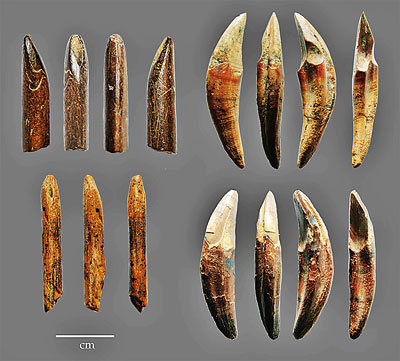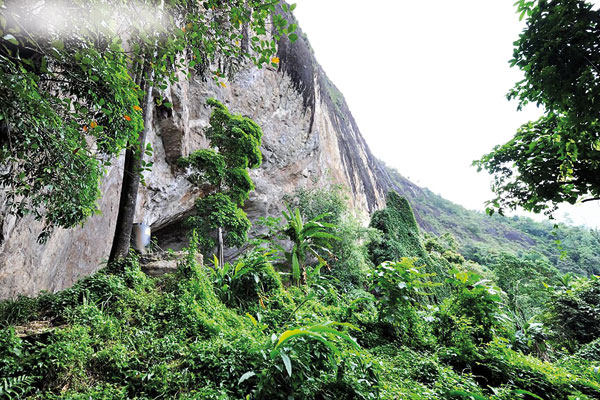Fa-Hien cave in forefront of new finds on Homo sapiens
Exciting research based on finds at the Fa-Hien Lena (cave) in Kalutara are transforming anthropologists’ understanding of how Homo sapiens moved through our world some 45,000 years ago, while offering an explanation for why we are today the solitary survivors from a family tree that once included other hominins such as Neanderthals and Homo erectus.

Found at the site: Cercopithecid tools
Detailed excavations at the rainforest cave are unearthing the oldest and longest record of sophisticated, active primate hunting by foragers. The findings reveal that our ancestors were wily hunters, feasting on large, agile tree-dwelling mammals – including adult monkeys and giant squirrels – much earlier than previously believed. In fact, these early hunters took the bones from their victims and turned them into tools that were used to hunt more monkeys, with evidence that they created projectiles.
The study, published in the journal Nature Communications, analysed over 14,000 bones preserved in the site, as well as associated plants and animals. Located in southwestern Sri Lanka, the cave has been studied since the 1980s, and is the earliest site of human occupation on the island. Human remains found there – comprising three children and an adult female – date to around 30,000 years ago.
In 2011, Oshan Wedage from the Department of History and Archaeology, University of Sri Jayewardenepura, alongside Siran Deraniyagala and Nimal Perera re-excavated the site. Noel Amano, Oshan’s co-lead, looked for evidence of cut marks and burning on the bones.
Dr. Patrick Roberts, Group Leader of the Stable Isotope Laboratory, Department of Archaeology at Max Planck Institute for the Science of Human History in Jena, Germany, was one of the co-authors of the study. He tells the Sunday Times: “Our findings further show that archaeologists and palaeo-anthropologists who assume rainforests were unattractive for human occupation need to take another look at our species’ capacities.”
To be fair, rainforests have never seemed a particularly inviting environment: they didn’t have the large herds of big animals found in the savannahs, and what they did have – large predators such as tigers and jaguars; limited sources of carbohydrates; high temperature and humidity as well as numerous diseases – should have made them unwelcoming.
Instead the researchers found that Homo sapiens moved in and settled down. The evidence of bones, projectiles and tools that have been found at the site indicate that these bands were hunting large adult monkeys and squirrels – the most challenging kind of prey. The stable isotope analysis also confirmed that humans were relying on these resources year round, and did not move into more open settings during any part of the year.
The landscape was a different one: research has indicated that that rainforests in the Wet Zone of Sri Lanka were more patchy and slightly drier from 36,000 through 20,000 years ago (the Last Glacial Maximum). This makes the find even more significant, says Dr. Roberts, pointing out that Homo sapiens chose to live in the challenging rainforest habitat even when other environments were available.
The other question raised by the study is how Homo sapiens eventually beat out bands of other hominins such as the Neanderthals, Denisovans, Homo erectus and Homo floresiensis to be the last left standing. The ecological evidence for these other hominins suggests a broad reliance on mixed grassland and dry forest environments, notes Dr. Roberts, adding:“By contrast, as Homo sapiens moved around the world, it is becoming clear that it could specialise in the use of extreme environments…”

He explains that this skill, supported by other qualities such as unparalleled social connectivity and communication, allowed Homo sapiens to not only ‘generalise’ in inhabiting a number of different environments, but also enabled whole populations ‘specialising’ in the long-term use of specific settings such as deserts, high altitude settings, the palaeoarctic, and, of course, tropical forests, giving them an advantage over other hominins.
Going forward, the team plans to undertake further detailed analysis of the bone and stone tools at the sites to see if they can glean any further details.
In a release, Prof. Michael Petraglia of the Max Planck Institute for the Science of Human History, a senior author of the study, said: “This ‘monkey menu’ was not a one-off, however, and the use of these difficult-to-catch resources is one more example of the behavioural and technological flexibility of H. sapiens.” Concludes, Dr. Roberts: “We also want to look in other environments in Sri Lanka to see if different human populations lived in other settings from 45,000 years ago onwards.”


